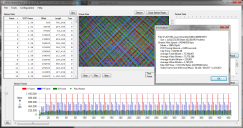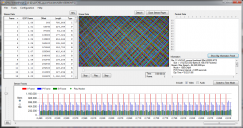
Please, support PV!
It allows to keep PV going, with more focus towards AI, but keeping be one of the few truly independent places.
It allows to keep PV going, with more focus towards AI, but keeping be one of the few truly independent places.
Official Low GOP topic, series 2
-
@sohus
Since my English is poor, there is no telling whether I am well told to you, but I consider being satisfactorily stabilized, if it is only the purpose to enlarge frame size at the time of high stress, and Q value is raised.
For example...
http://www.personal-view.com/talks/discussion/comment/19360#Comment_19360
I do not feel interest to this stable setting because frame size will become small too much under the influence of AQ1 at the lowlight. -
-
@driftwood At what setting did you see it pullback ? Seriously, I've seen higher than that run for over a minute to two with the 66M AQ2 without falling back. I run deathchart tests for at least 2 minutes (usually over) to check for cadence problems so I've seen it hold consistently over 1,000,000 quite a lot. Pretty sure @proaudio4 has seen that too, as IIRC he also runs deathchart tests in excess of 2 minutes. Or are you all talking about low GOPs only ? You do know that doing the T1 T4 setting is known to cause the camera to pullback some way into a shot ? Which was discussed/observed when it was first mooted as a fix for the cadence pulsing, and @proaudio4 raised it again more recently. Maybe thats what you're seeing.
@sohus I've enclosed a deathchart test of my 88M AQ2 running at ISO 800 SS 1/125 to show that the camera can be consistent at a high frame size. Two images, one at the start of the stream and one at the end. Shot length is 2 minutes (I've also just found a 2 and a half minute shot with the same frame sizes that remains consistent).
@bkmcwd yes, keeping it around 150M is the best bet as its easier for all of us to find SD cards that can handle that.
 88M AQ2 start ISO800 SS125.png1297 x 683 - 447K
88M AQ2 start ISO800 SS125.png1297 x 683 - 447K
 88M AQ2 end ISO800 SS125.png1297 x 683 - 474K
88M AQ2 end ISO800 SS125.png1297 x 683 - 474K -
@Stray I dont use t4 = T1. It was suggested to me by others and I passed it on thinking it helped. However, eventually I couldnt see the benefit. I run all my tests for 2 mins and like yours have many many times over the 1,000,000. Im talking about peak sustained on the buffer chart. Ive seen instability on 66M on the buffers and I still think it could be improved. Its not really what Ive been testing though, Ive barely looked at 44M, 66M, or other 12 GOPs. I do like chris's 44m. But it doesnt mean its the be all and end all!
-
Someone just try the P/B GOP3s - please!!!!
-
@driftwood ah right, gotcha. But I don't get what difference that actually makes (or what exactly elecard tells you) when the footage and the stream are completely perfect under extreme stress. Also the 44 is lovely to me too, but to me fast motion suffers a bit and Ralph_Bs HDMI comparison tests proved that too IIRC. Its Chris's 66M AQ2 which is amazing, its been my baseline for comparing every other settings result too since it was released.
-
Elecard buffer analysis can report minute drops and rises from the constant.
-
Constant what ? It is actually giving you the playback buffer performance, not how the actual buffer in the camera performed or functioned during recording. It doesn't actually, so it seems to me, point to any information relating to in camera stability during recording. Or am I mssing something ? Don't hold back on the information, I'll probably get my head round it, .er.. eventually. I taught myself my first programming language (north star basic) over 30 years ago, and I've been working with and using digital video for nigh on twenty years (and analog video and 8mm and 16mm film before that). So, hopefully, breaking down an explanation won't be too painful. Oh, and maybe PM it if you want to keep the thread clean of it.
-
timing
-
@Stray Are you suggesting you are qualified?
-
@driftwood No I'm not, I'm just saying that I'd like to know how elecards buffer analyser gives you information relating to in camera stability at certain settings, as it cannot tell you about how the in cameras record buffer performed. I added some of my background to assure you that it won't be a complete PITA to actually explain it.
-
Because you can see the recordings initial_cpb_removal_delay_offset timing/ buffer underflows and overflows, etc... and measure what bitrate to video buffer setting to employ to an enth degree. If its a pointless program I suggest you email them.
-
@stray Good grief, I'm not challenging the program at all, I'm merely asking you how the analysis it gives you, analysing a buffer different to the one that is actually in camera (playback buffer) is indicating that a setting is actually stable. Thats all, settle down.
Please stop throwing around terms in sentences that actually say nothing at all. -
The whole point of this thread is to discuss and demonstrate patches around Short GOP. Lets leave it at that. We all know that motion difffers over GOPs. For those who dont like short GOP, theres the max thread etc...
-
I agree, thats why I suggested PM. You don't seem to want to offer an explanation/answer anyway so lets drop it.
Edit: However your statements are giving others the impression that settings aren't stable/quite right based on the elecard analysis. You may be completely correct in these statements, all I wanted was an explanation of what its analysis provides that points towards your statements. If only so I, and maybe others, could understand and have confidence in them. We're all sharing knowledge and our findings here after all. Streamparser, for me, is pretty clear when things are stable or not, and we can also check the footage in post with brutal tests too. -
What did you want to know? It may playback in the camera fine but as we know there could be hidden problems, thats why I always use Elecard buffer analysis to look at the recording along with streamparser and streameye to measure all the possibilities. Even after two minutes on a static the video buffer graph could begin to slide. Its nice to visualise these things.
-
Stray you are correct regarding T4=T1. After so many frames it eventually drops i-frame size. I'd stay away until we know more.
Also, I'm not sure why the 44M AQ4 GOP12 ended up in this topic. You're right, Ralph_B 's HDMI comparison to 44M AQ4 under motion was not good. It was the worse out of all the tests. (He did not test stock settings).
66M AQ2 (8/29) for 24H is rock solid. Alhtough, I can't disagree with driftwood "stability all round"
since his message is not particular to 24H, but all settings in the 44M verses 66M. -
bkmcwd and driftwood, where are your lastest GOP3 ini files?
Sorry, if I missed them... -
@proaudio4 Look for GOP3ILLA. Theyre insane!
-
Thank you!
-
@proaudio4
My latest ini file is here.
http://www.personal-view.com/talks/discussion/comment/19588#Comment_19588
If you cannot rocord under extream stress, please back to this. :-)
http://www.personal-view.com/talks/discussion/comment/19484#Comment_19484 -
Thanks bkmcwd!,
If you can not record under stress, have you tried to bring your limits down a bit?
My goal is the same as yours (and most others) to have the largest i-frame under low light conditions.
But it must be stable under high detail motion. I imagine (like stray mentioned) GOP3 is probably the way to go around the 150M - 160M range. Hopefully you can fine tune this for stability.
I realize that normally we do not record high ISO dense charts, but the idea that there's a possiblity a shot "may" be no good does worry me, especially on a paid ($$) job.
-
@proaudio4
Welcome!
" limits down a bit?"
Yes!
#19588…FLx1
#19484…FLx0.95
As I mentioned, I am not sure that my test is enough or not…
EDIT:
I also think that if you cannot record, you can try to change Top&Bottom multiple from 6.6 to 6.5. -
thanks bkmcwd, cheers!
-
driftwood,
Have you determined the limitation on datarate? Is the bottleneck happening on the databus for SDHC, or is a different hardware, or AVCHD limitation?
Yes, I do know that not many cards can sustain over 15MB/s. Also, I imagine burst speed rates may matter too.
We really need to sort these fucking cards out and really weed out the best. The problem is there's slight differences occuring off the manufacture line and also there's fake one out there too.
This is a bit frustrating since USB 2.0 speeds max bandwidth is "supposed" to be 60MB/s (480mbps)
The reason I ask, is that in the end > as you know GOP1 is the best for motion and post work.
I know we are hitting a bandwidth limitation. If we could just figure out what limit we're hitting first.
This topic is closed.
← All Discussions Start New Topic


Howdy, Stranger!
It looks like you're new here. If you want to get involved, click one of these buttons!
Categories
- Topics List23,993
- Blog5,725
- General and News1,354
- Hacks and Patches1,153
- ↳ Top Settings33
- ↳ Beginners256
- ↳ Archives402
- ↳ Hacks News and Development56
- Cameras2,368
- ↳ Panasonic995
- ↳ Canon118
- ↳ Sony156
- ↳ Nikon96
- ↳ Pentax and Samsung70
- ↳ Olympus and Fujifilm102
- ↳ Compacts and Camcorders300
- ↳ Smartphones for video97
- ↳ Pro Video Cameras191
- ↳ BlackMagic and other raw cameras116
- Skill1,960
- ↳ Business and distribution66
- ↳ Preparation, scripts and legal38
- ↳ Art149
- ↳ Import, Convert, Exporting291
- ↳ Editors191
- ↳ Effects and stunts115
- ↳ Color grading197
- ↳ Sound and Music280
- ↳ Lighting96
- ↳ Software and storage tips266
- Gear5,420
- ↳ Filters, Adapters, Matte boxes344
- ↳ Lenses1,582
- ↳ Follow focus and gears93
- ↳ Sound499
- ↳ Lighting gear314
- ↳ Camera movement230
- ↳ Gimbals and copters302
- ↳ Rigs and related stuff273
- ↳ Power solutions83
- ↳ Monitors and viewfinders340
- ↳ Tripods and fluid heads139
- ↳ Storage286
- ↳ Computers and studio gear560
- ↳ VR and 3D248
- Showcase1,859
- Marketplace2,834
- Offtopic1,320





